Teaching and Learning in Inclusive Settings: A UDL Approach
VerifiedAdded on 2023/06/11
|14
|3121
|286
AI Summary
This report discusses a teaching plan for students in a diverse classroom environment, learning outcomes, and lesson descriptions. It explores the Universal Design for Learning (UDL) framework and its implementation in the context of Australian curriculum. The report also highlights the relationship of the plan with UDL and its justification for collaboration, team bonding, and communication.
Contribute Materials
Your contribution can guide someone’s learning journey. Share your
documents today.
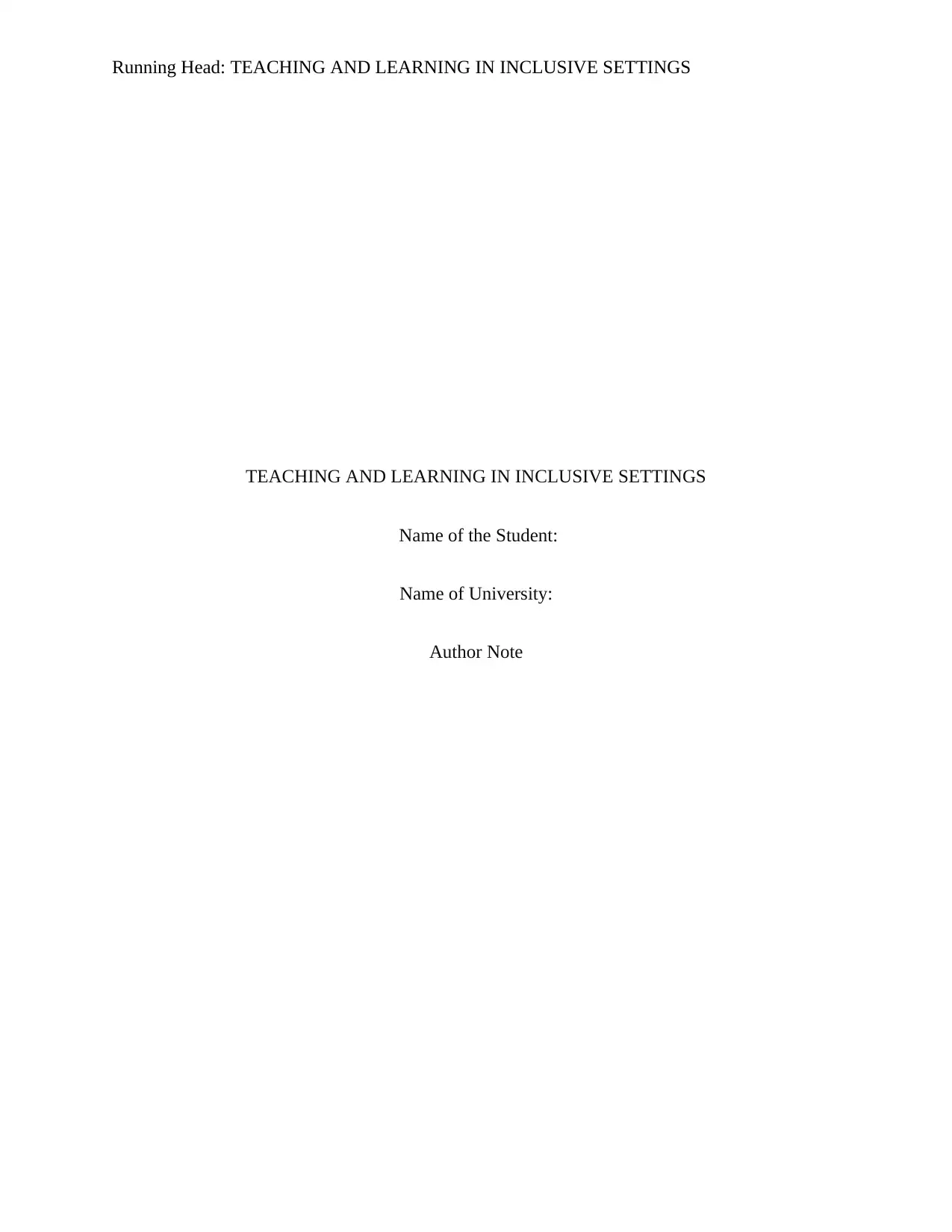
Running Head: TEACHING AND LEARNING IN INCLUSIVE SETTINGS
TEACHING AND LEARNING IN INCLUSIVE SETTINGS
Name of the Student:
Name of University:
Author Note
TEACHING AND LEARNING IN INCLUSIVE SETTINGS
Name of the Student:
Name of University:
Author Note
Secure Best Marks with AI Grader
Need help grading? Try our AI Grader for instant feedback on your assignments.
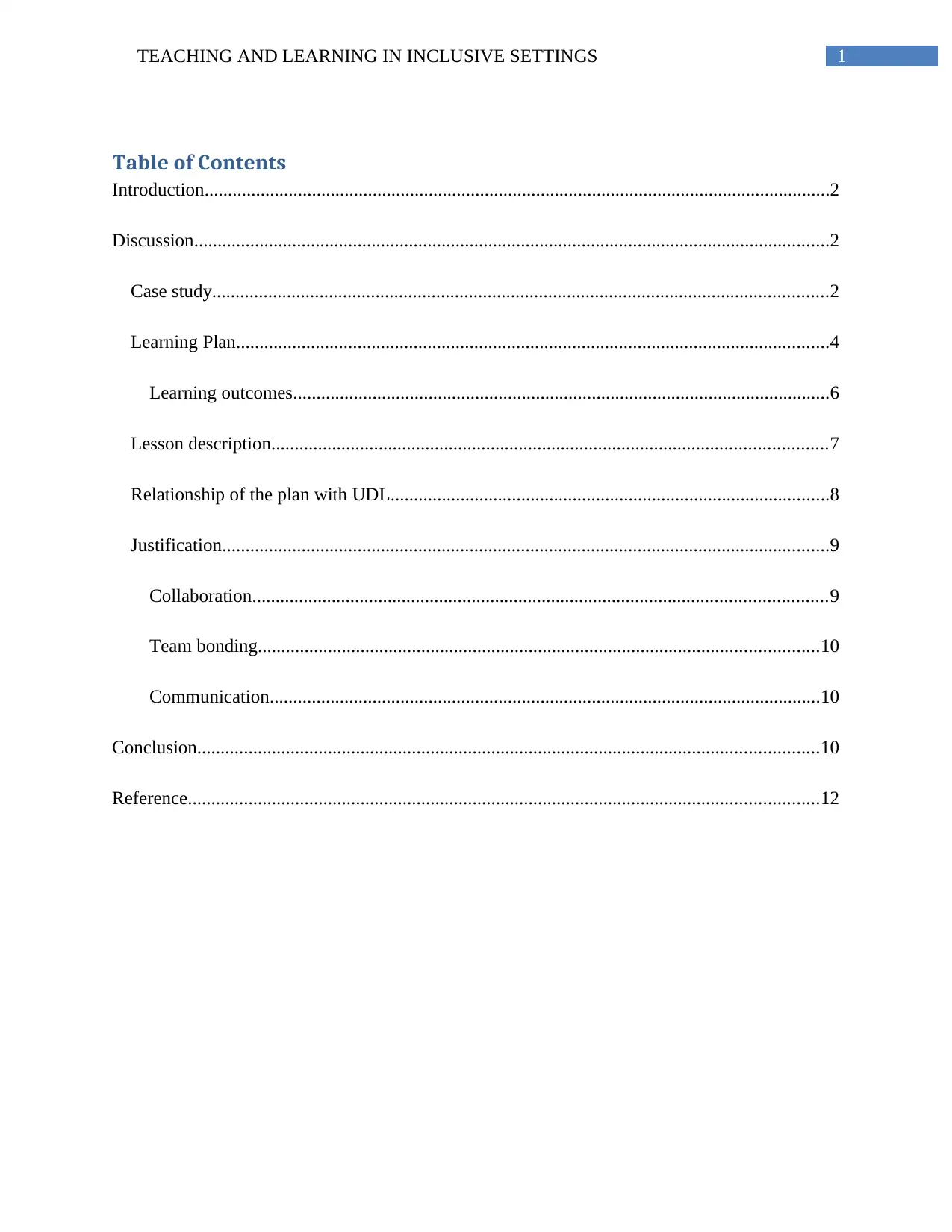
1TEACHING AND LEARNING IN INCLUSIVE SETTINGS
Table of Contents
Introduction......................................................................................................................................2
Discussion........................................................................................................................................2
Case study....................................................................................................................................2
Learning Plan...............................................................................................................................4
Learning outcomes...................................................................................................................6
Lesson description.......................................................................................................................7
Relationship of the plan with UDL..............................................................................................8
Justification..................................................................................................................................9
Collaboration...........................................................................................................................9
Team bonding........................................................................................................................10
Communication......................................................................................................................10
Conclusion.....................................................................................................................................10
Reference.......................................................................................................................................12
Table of Contents
Introduction......................................................................................................................................2
Discussion........................................................................................................................................2
Case study....................................................................................................................................2
Learning Plan...............................................................................................................................4
Learning outcomes...................................................................................................................6
Lesson description.......................................................................................................................7
Relationship of the plan with UDL..............................................................................................8
Justification..................................................................................................................................9
Collaboration...........................................................................................................................9
Team bonding........................................................................................................................10
Communication......................................................................................................................10
Conclusion.....................................................................................................................................10
Reference.......................................................................................................................................12
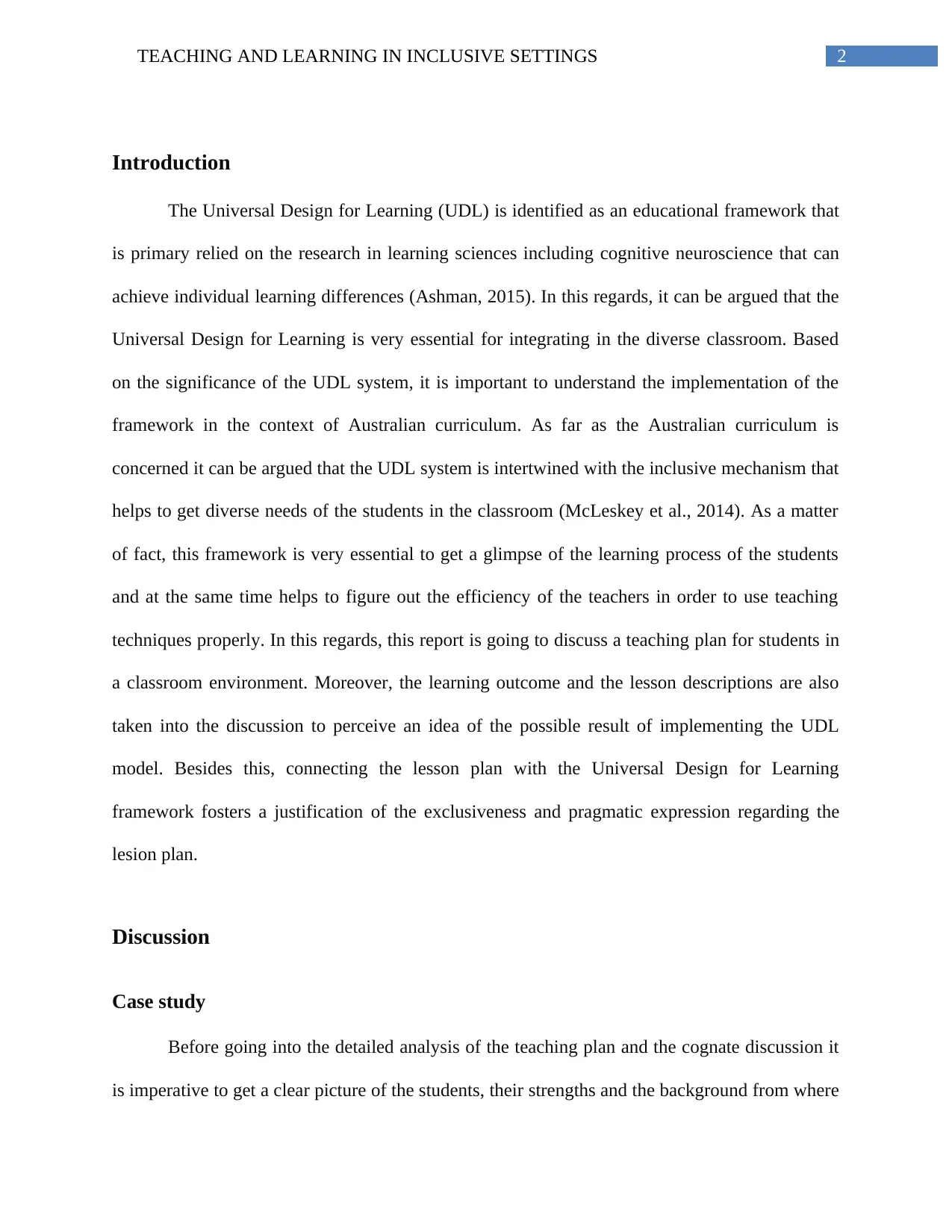
2TEACHING AND LEARNING IN INCLUSIVE SETTINGS
Introduction
The Universal Design for Learning (UDL) is identified as an educational framework that
is primary relied on the research in learning sciences including cognitive neuroscience that can
achieve individual learning differences (Ashman, 2015). In this regards, it can be argued that the
Universal Design for Learning is very essential for integrating in the diverse classroom. Based
on the significance of the UDL system, it is important to understand the implementation of the
framework in the context of Australian curriculum. As far as the Australian curriculum is
concerned it can be argued that the UDL system is intertwined with the inclusive mechanism that
helps to get diverse needs of the students in the classroom (McLeskey et al., 2014). As a matter
of fact, this framework is very essential to get a glimpse of the learning process of the students
and at the same time helps to figure out the efficiency of the teachers in order to use teaching
techniques properly. In this regards, this report is going to discuss a teaching plan for students in
a classroom environment. Moreover, the learning outcome and the lesson descriptions are also
taken into the discussion to perceive an idea of the possible result of implementing the UDL
model. Besides this, connecting the lesson plan with the Universal Design for Learning
framework fosters a justification of the exclusiveness and pragmatic expression regarding the
lesion plan.
Discussion
Case study
Before going into the detailed analysis of the teaching plan and the cognate discussion it
is imperative to get a clear picture of the students, their strengths and the background from where
Introduction
The Universal Design for Learning (UDL) is identified as an educational framework that
is primary relied on the research in learning sciences including cognitive neuroscience that can
achieve individual learning differences (Ashman, 2015). In this regards, it can be argued that the
Universal Design for Learning is very essential for integrating in the diverse classroom. Based
on the significance of the UDL system, it is important to understand the implementation of the
framework in the context of Australian curriculum. As far as the Australian curriculum is
concerned it can be argued that the UDL system is intertwined with the inclusive mechanism that
helps to get diverse needs of the students in the classroom (McLeskey et al., 2014). As a matter
of fact, this framework is very essential to get a glimpse of the learning process of the students
and at the same time helps to figure out the efficiency of the teachers in order to use teaching
techniques properly. In this regards, this report is going to discuss a teaching plan for students in
a classroom environment. Moreover, the learning outcome and the lesson descriptions are also
taken into the discussion to perceive an idea of the possible result of implementing the UDL
model. Besides this, connecting the lesson plan with the Universal Design for Learning
framework fosters a justification of the exclusiveness and pragmatic expression regarding the
lesion plan.
Discussion
Case study
Before going into the detailed analysis of the teaching plan and the cognate discussion it
is imperative to get a clear picture of the students, their strengths and the background from where
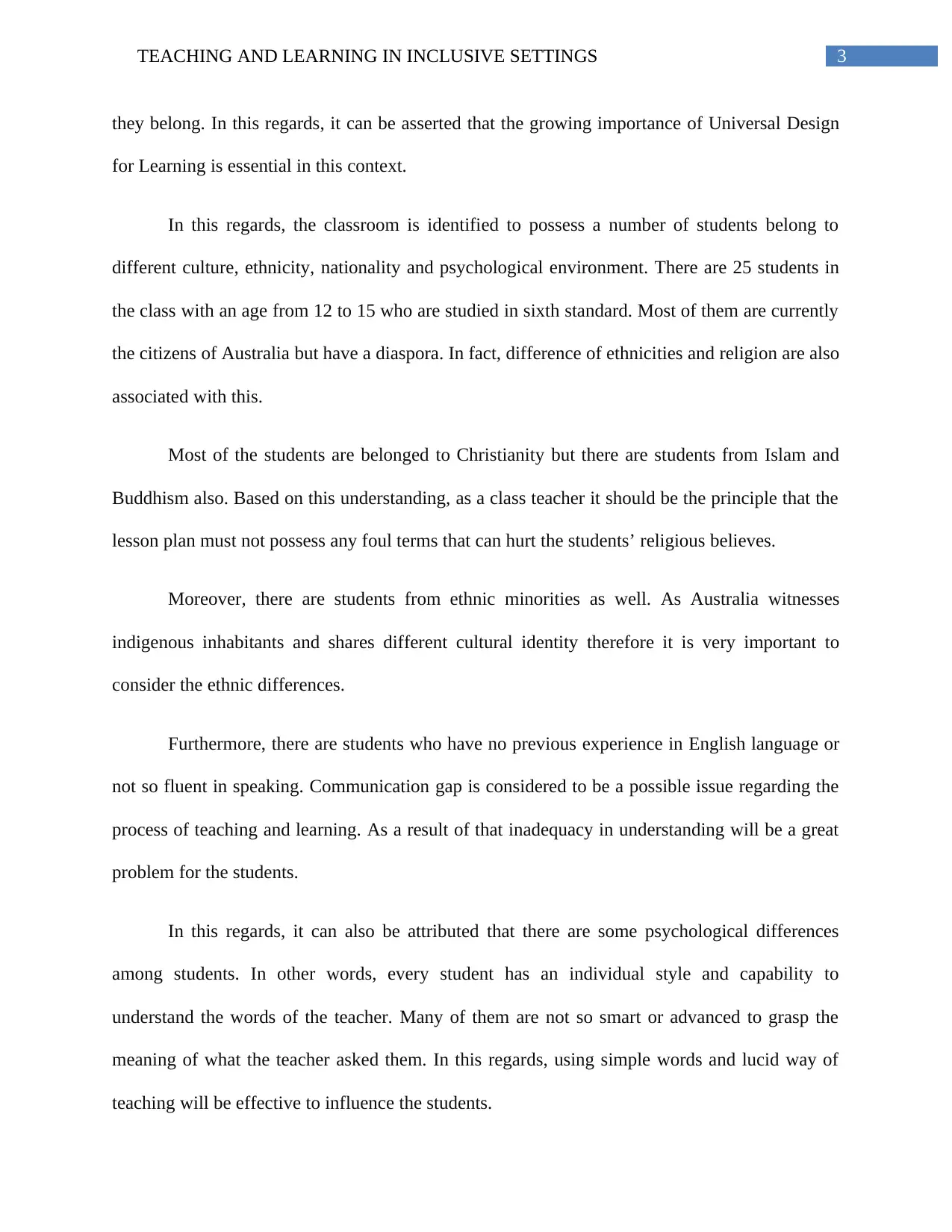
3TEACHING AND LEARNING IN INCLUSIVE SETTINGS
they belong. In this regards, it can be asserted that the growing importance of Universal Design
for Learning is essential in this context.
In this regards, the classroom is identified to possess a number of students belong to
different culture, ethnicity, nationality and psychological environment. There are 25 students in
the class with an age from 12 to 15 who are studied in sixth standard. Most of them are currently
the citizens of Australia but have a diaspora. In fact, difference of ethnicities and religion are also
associated with this.
Most of the students are belonged to Christianity but there are students from Islam and
Buddhism also. Based on this understanding, as a class teacher it should be the principle that the
lesson plan must not possess any foul terms that can hurt the students’ religious believes.
Moreover, there are students from ethnic minorities as well. As Australia witnesses
indigenous inhabitants and shares different cultural identity therefore it is very important to
consider the ethnic differences.
Furthermore, there are students who have no previous experience in English language or
not so fluent in speaking. Communication gap is considered to be a possible issue regarding the
process of teaching and learning. As a result of that inadequacy in understanding will be a great
problem for the students.
In this regards, it can also be attributed that there are some psychological differences
among students. In other words, every student has an individual style and capability to
understand the words of the teacher. Many of them are not so smart or advanced to grasp the
meaning of what the teacher asked them. In this regards, using simple words and lucid way of
teaching will be effective to influence the students.
they belong. In this regards, it can be asserted that the growing importance of Universal Design
for Learning is essential in this context.
In this regards, the classroom is identified to possess a number of students belong to
different culture, ethnicity, nationality and psychological environment. There are 25 students in
the class with an age from 12 to 15 who are studied in sixth standard. Most of them are currently
the citizens of Australia but have a diaspora. In fact, difference of ethnicities and religion are also
associated with this.
Most of the students are belonged to Christianity but there are students from Islam and
Buddhism also. Based on this understanding, as a class teacher it should be the principle that the
lesson plan must not possess any foul terms that can hurt the students’ religious believes.
Moreover, there are students from ethnic minorities as well. As Australia witnesses
indigenous inhabitants and shares different cultural identity therefore it is very important to
consider the ethnic differences.
Furthermore, there are students who have no previous experience in English language or
not so fluent in speaking. Communication gap is considered to be a possible issue regarding the
process of teaching and learning. As a result of that inadequacy in understanding will be a great
problem for the students.
In this regards, it can also be attributed that there are some psychological differences
among students. In other words, every student has an individual style and capability to
understand the words of the teacher. Many of them are not so smart or advanced to grasp the
meaning of what the teacher asked them. In this regards, using simple words and lucid way of
teaching will be effective to influence the students.
Secure Best Marks with AI Grader
Need help grading? Try our AI Grader for instant feedback on your assignments.
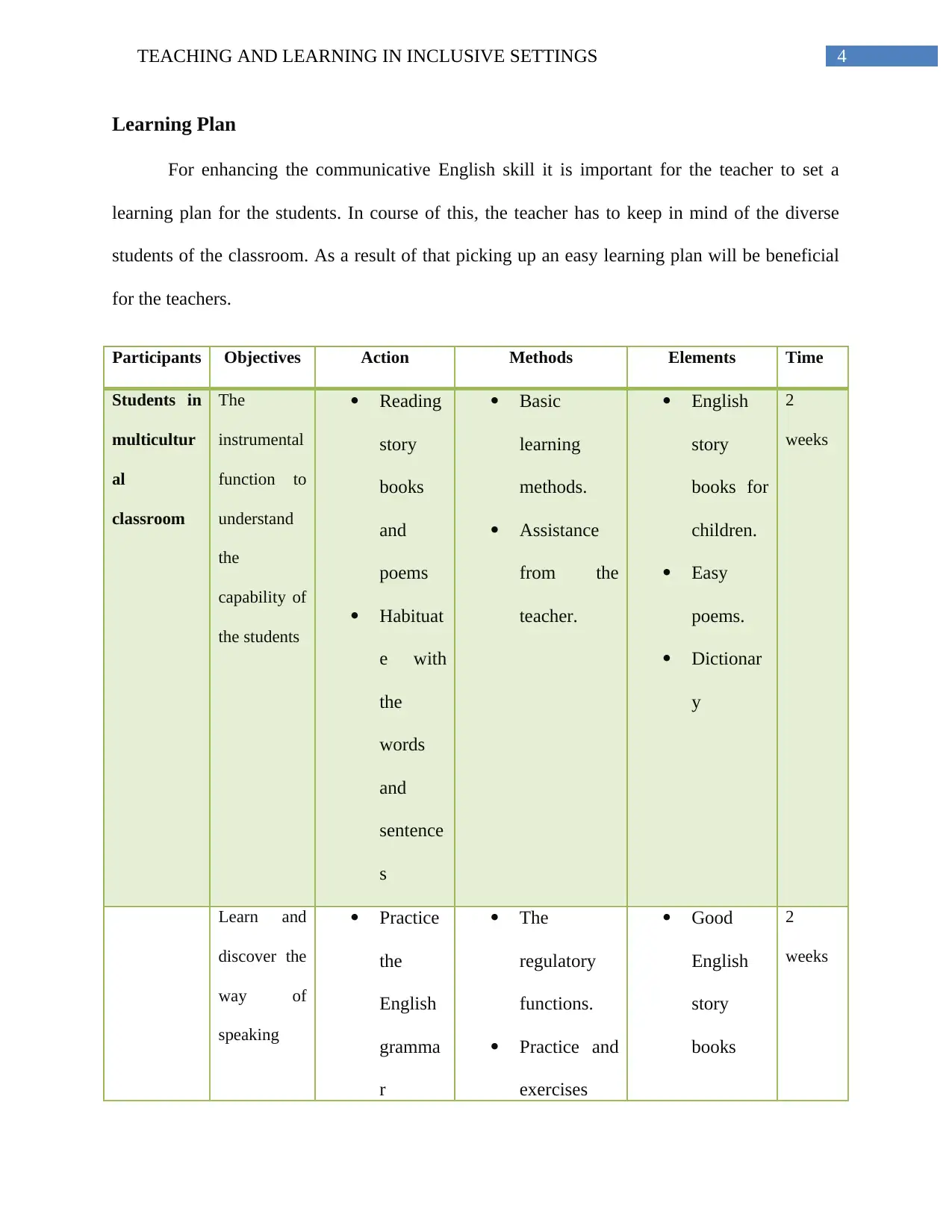
4TEACHING AND LEARNING IN INCLUSIVE SETTINGS
Learning Plan
For enhancing the communicative English skill it is important for the teacher to set a
learning plan for the students. In course of this, the teacher has to keep in mind of the diverse
students of the classroom. As a result of that picking up an easy learning plan will be beneficial
for the teachers.
Participants Objectives Action Methods Elements Time
Students in
multicultur
al
classroom
The
instrumental
function to
understand
the
capability of
the students
Reading
story
books
and
poems
Habituat
e with
the
words
and
sentence
s
Basic
learning
methods.
Assistance
from the
teacher.
English
story
books for
children.
Easy
poems.
Dictionar
y
2
weeks
Learn and
discover the
way of
speaking
Practice
the
English
gramma
r
The
regulatory
functions.
Practice and
exercises
Good
English
story
books
2
weeks
Learning Plan
For enhancing the communicative English skill it is important for the teacher to set a
learning plan for the students. In course of this, the teacher has to keep in mind of the diverse
students of the classroom. As a result of that picking up an easy learning plan will be beneficial
for the teachers.
Participants Objectives Action Methods Elements Time
Students in
multicultur
al
classroom
The
instrumental
function to
understand
the
capability of
the students
Reading
story
books
and
poems
Habituat
e with
the
words
and
sentence
s
Basic
learning
methods.
Assistance
from the
teacher.
English
story
books for
children.
Easy
poems.
Dictionar
y
2
weeks
Learn and
discover the
way of
speaking
Practice
the
English
gramma
r
The
regulatory
functions.
Practice and
exercises
Good
English
story
books
2
weeks
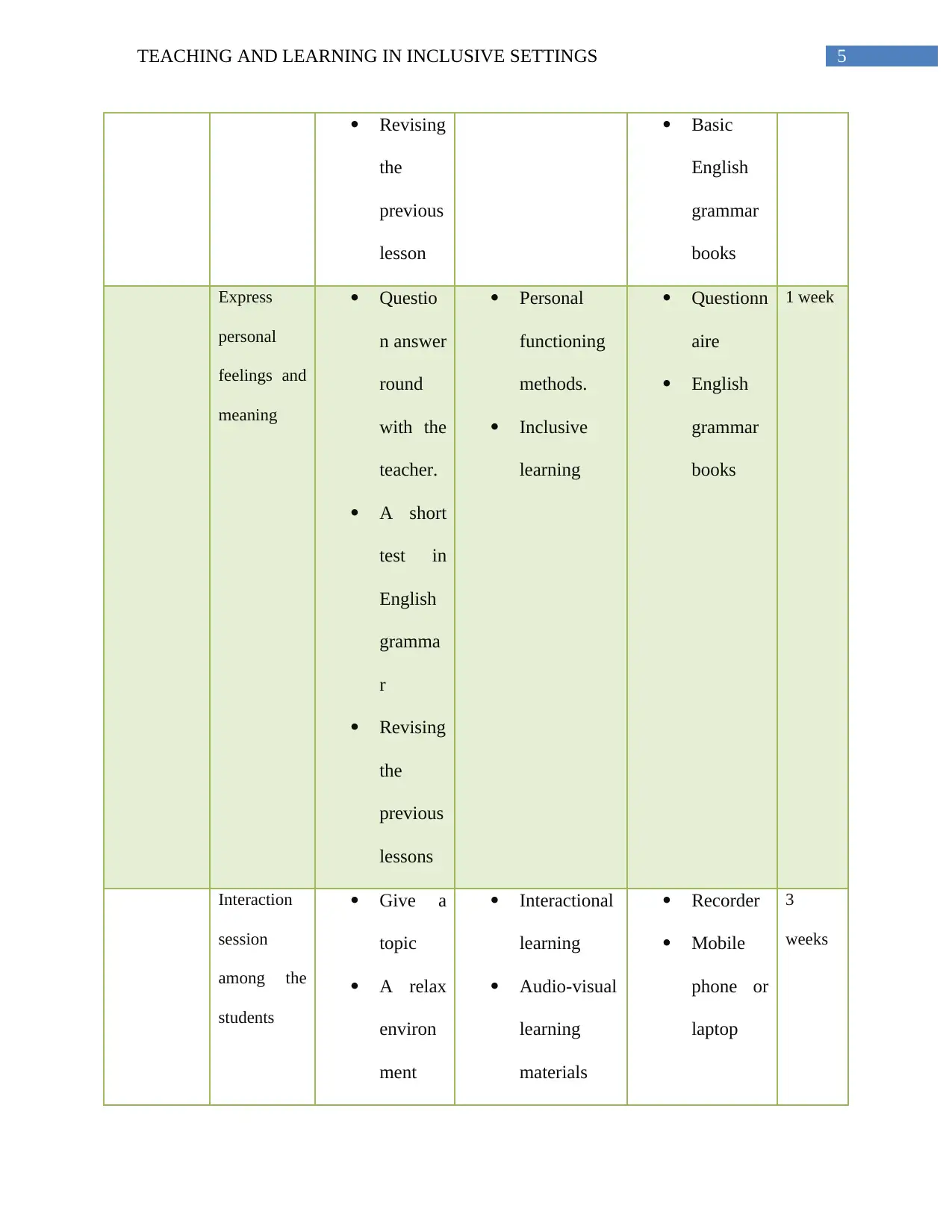
5TEACHING AND LEARNING IN INCLUSIVE SETTINGS
Revising
the
previous
lesson
Basic
English
grammar
books
Express
personal
feelings and
meaning
Questio
n answer
round
with the
teacher.
A short
test in
English
gramma
r
Revising
the
previous
lessons
Personal
functioning
methods.
Inclusive
learning
Questionn
aire
English
grammar
books
1 week
Interaction
session
among the
students
Give a
topic
A relax
environ
ment
Interactional
learning
Audio-visual
learning
materials
Recorder
Mobile
phone or
laptop
3
weeks
Revising
the
previous
lesson
Basic
English
grammar
books
Express
personal
feelings and
meaning
Questio
n answer
round
with the
teacher.
A short
test in
English
gramma
r
Revising
the
previous
lessons
Personal
functioning
methods.
Inclusive
learning
Questionn
aire
English
grammar
books
1 week
Interaction
session
among the
students
Give a
topic
A relax
environ
ment
Interactional
learning
Audio-visual
learning
materials
Recorder
Mobile
phone or
laptop
3
weeks
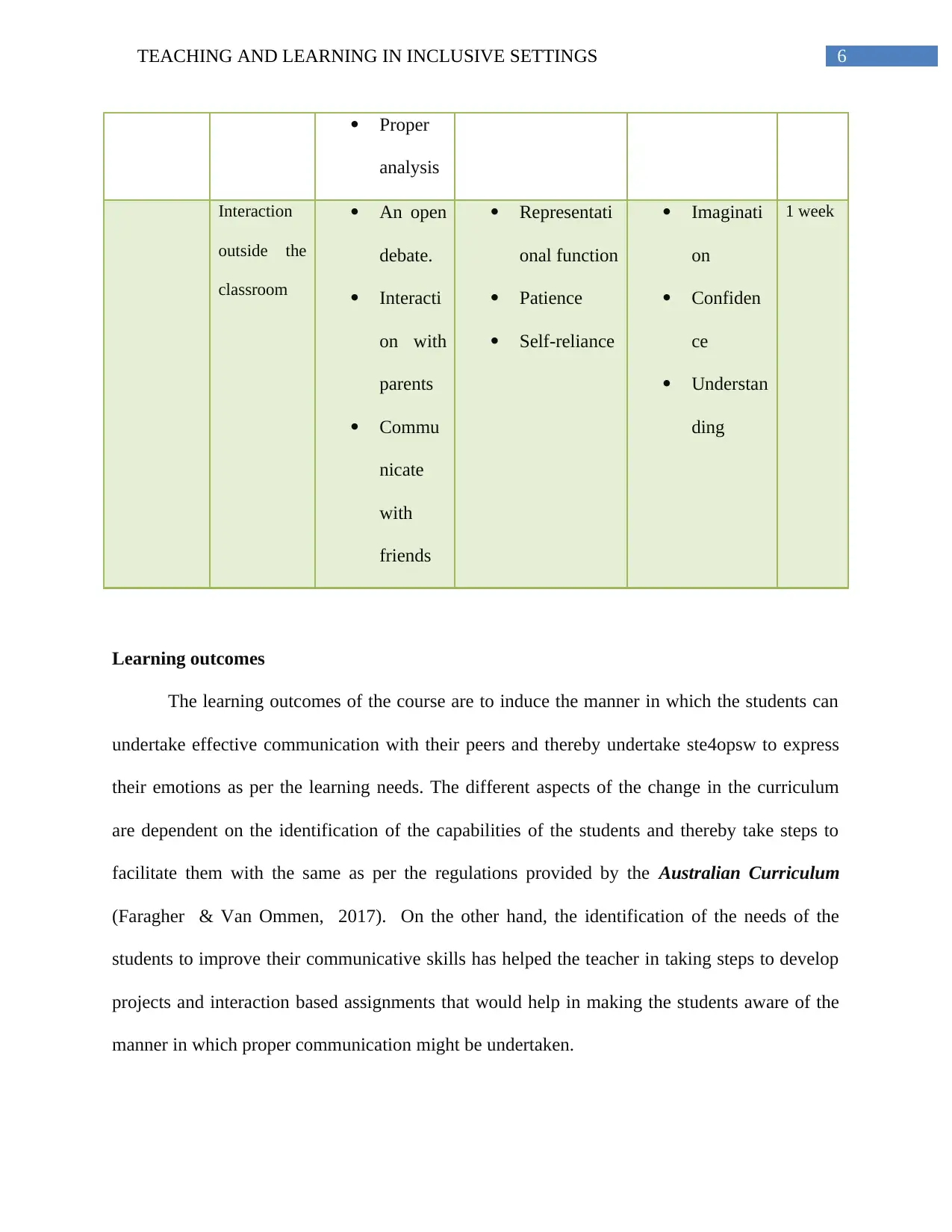
6TEACHING AND LEARNING IN INCLUSIVE SETTINGS
Proper
analysis
Interaction
outside the
classroom
An open
debate.
Interacti
on with
parents
Commu
nicate
with
friends
Representati
onal function
Patience
Self-reliance
Imaginati
on
Confiden
ce
Understan
ding
1 week
Learning outcomes
The learning outcomes of the course are to induce the manner in which the students can
undertake effective communication with their peers and thereby undertake ste4opsw to express
their emotions as per the learning needs. The different aspects of the change in the curriculum
are dependent on the identification of the capabilities of the students and thereby take steps to
facilitate them with the same as per the regulations provided by the Australian Curriculum
(Faragher & Van Ommen, 2017). On the other hand, the identification of the needs of the
students to improve their communicative skills has helped the teacher in taking steps to develop
projects and interaction based assignments that would help in making the students aware of the
manner in which proper communication might be undertaken.
Proper
analysis
Interaction
outside the
classroom
An open
debate.
Interacti
on with
parents
Commu
nicate
with
friends
Representati
onal function
Patience
Self-reliance
Imaginati
on
Confiden
ce
Understan
ding
1 week
Learning outcomes
The learning outcomes of the course are to induce the manner in which the students can
undertake effective communication with their peers and thereby undertake ste4opsw to express
their emotions as per the learning needs. The different aspects of the change in the curriculum
are dependent on the identification of the capabilities of the students and thereby take steps to
facilitate them with the same as per the regulations provided by the Australian Curriculum
(Faragher & Van Ommen, 2017). On the other hand, the identification of the needs of the
students to improve their communicative skills has helped the teacher in taking steps to develop
projects and interaction based assignments that would help in making the students aware of the
manner in which proper communication might be undertaken.
Paraphrase This Document
Need a fresh take? Get an instant paraphrase of this document with our AI Paraphraser
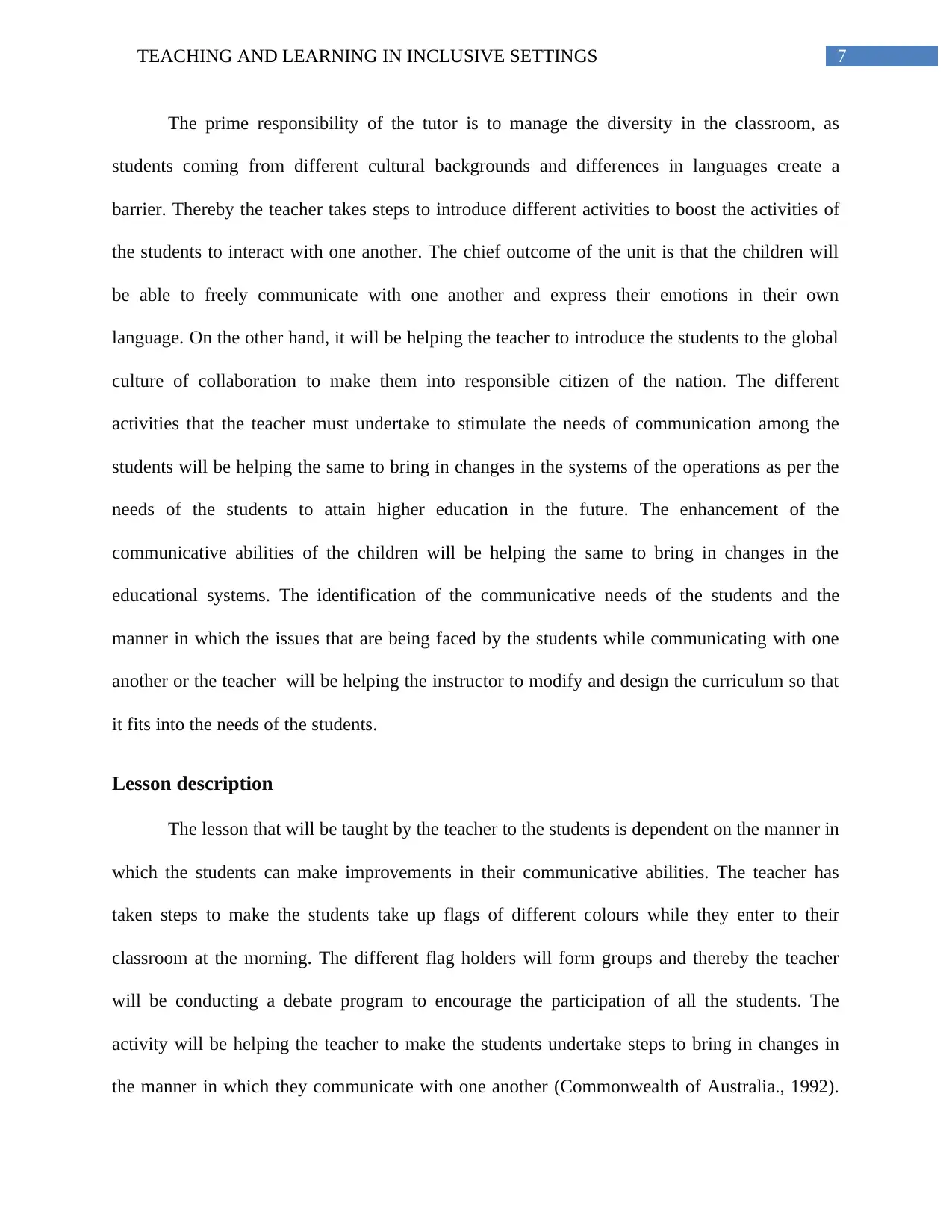
7TEACHING AND LEARNING IN INCLUSIVE SETTINGS
The prime responsibility of the tutor is to manage the diversity in the classroom, as
students coming from different cultural backgrounds and differences in languages create a
barrier. Thereby the teacher takes steps to introduce different activities to boost the activities of
the students to interact with one another. The chief outcome of the unit is that the children will
be able to freely communicate with one another and express their emotions in their own
language. On the other hand, it will be helping the teacher to introduce the students to the global
culture of collaboration to make them into responsible citizen of the nation. The different
activities that the teacher must undertake to stimulate the needs of communication among the
students will be helping the same to bring in changes in the systems of the operations as per the
needs of the students to attain higher education in the future. The enhancement of the
communicative abilities of the children will be helping the same to bring in changes in the
educational systems. The identification of the communicative needs of the students and the
manner in which the issues that are being faced by the students while communicating with one
another or the teacher will be helping the instructor to modify and design the curriculum so that
it fits into the needs of the students.
Lesson description
The lesson that will be taught by the teacher to the students is dependent on the manner in
which the students can make improvements in their communicative abilities. The teacher has
taken steps to make the students take up flags of different colours while they enter to their
classroom at the morning. The different flag holders will form groups and thereby the teacher
will be conducting a debate program to encourage the participation of all the students. The
activity will be helping the teacher to make the students undertake steps to bring in changes in
the manner in which they communicate with one another (Commonwealth of Australia., 1992).
The prime responsibility of the tutor is to manage the diversity in the classroom, as
students coming from different cultural backgrounds and differences in languages create a
barrier. Thereby the teacher takes steps to introduce different activities to boost the activities of
the students to interact with one another. The chief outcome of the unit is that the children will
be able to freely communicate with one another and express their emotions in their own
language. On the other hand, it will be helping the teacher to introduce the students to the global
culture of collaboration to make them into responsible citizen of the nation. The different
activities that the teacher must undertake to stimulate the needs of communication among the
students will be helping the same to bring in changes in the systems of the operations as per the
needs of the students to attain higher education in the future. The enhancement of the
communicative abilities of the children will be helping the same to bring in changes in the
educational systems. The identification of the communicative needs of the students and the
manner in which the issues that are being faced by the students while communicating with one
another or the teacher will be helping the instructor to modify and design the curriculum so that
it fits into the needs of the students.
Lesson description
The lesson that will be taught by the teacher to the students is dependent on the manner in
which the students can make improvements in their communicative abilities. The teacher has
taken steps to make the students take up flags of different colours while they enter to their
classroom at the morning. The different flag holders will form groups and thereby the teacher
will be conducting a debate program to encourage the participation of all the students. The
activity will be helping the teacher to make the students undertake steps to bring in changes in
the manner in which they communicate with one another (Commonwealth of Australia., 1992).
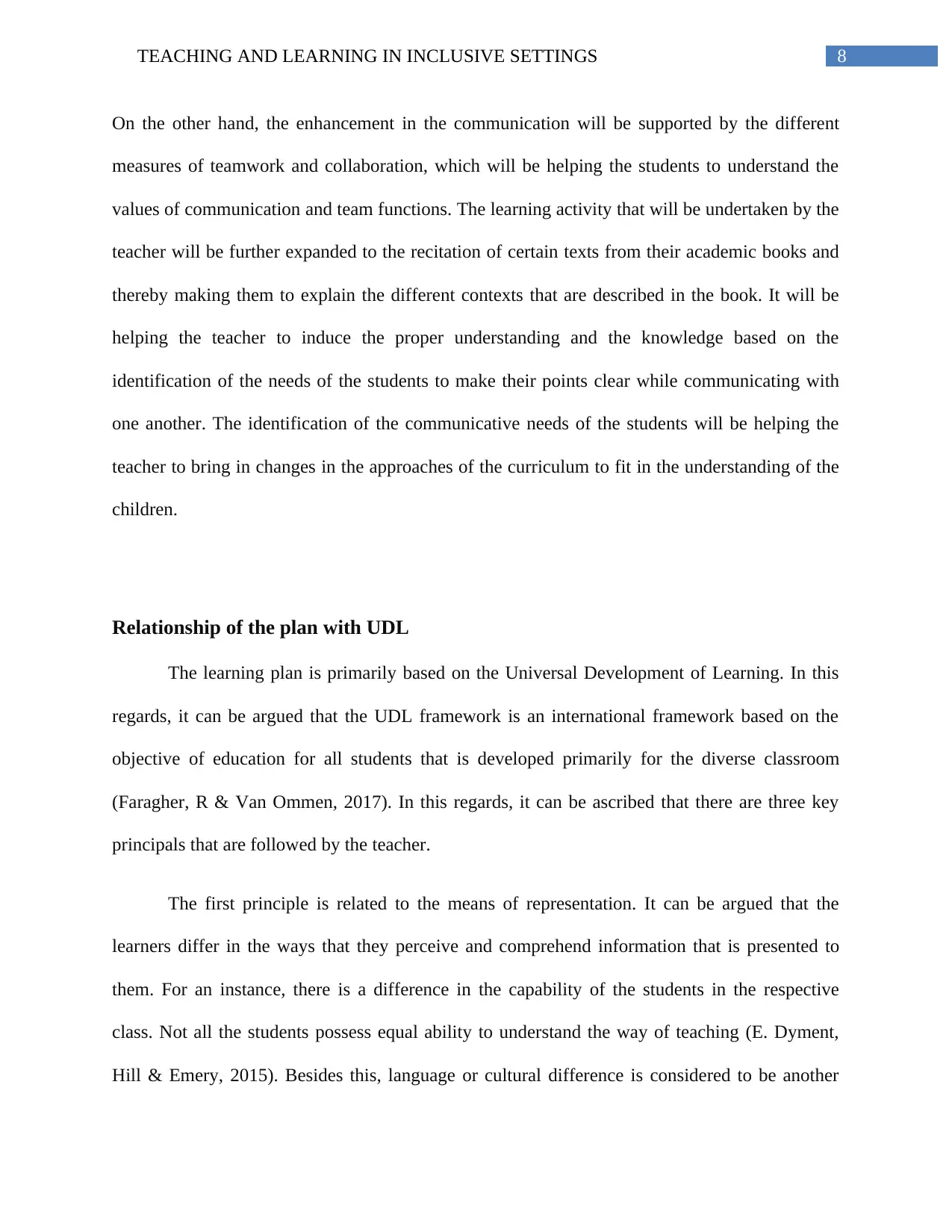
8TEACHING AND LEARNING IN INCLUSIVE SETTINGS
On the other hand, the enhancement in the communication will be supported by the different
measures of teamwork and collaboration, which will be helping the students to understand the
values of communication and team functions. The learning activity that will be undertaken by the
teacher will be further expanded to the recitation of certain texts from their academic books and
thereby making them to explain the different contexts that are described in the book. It will be
helping the teacher to induce the proper understanding and the knowledge based on the
identification of the needs of the students to make their points clear while communicating with
one another. The identification of the communicative needs of the students will be helping the
teacher to bring in changes in the approaches of the curriculum to fit in the understanding of the
children.
Relationship of the plan with UDL
The learning plan is primarily based on the Universal Development of Learning. In this
regards, it can be argued that the UDL framework is an international framework based on the
objective of education for all students that is developed primarily for the diverse classroom
(Faragher, R & Van Ommen, 2017). In this regards, it can be ascribed that there are three key
principals that are followed by the teacher.
The first principle is related to the means of representation. It can be argued that the
learners differ in the ways that they perceive and comprehend information that is presented to
them. For an instance, there is a difference in the capability of the students in the respective
class. Not all the students possess equal ability to understand the way of teaching (E. Dyment,
Hill & Emery, 2015). Besides this, language or cultural difference is considered to be another
On the other hand, the enhancement in the communication will be supported by the different
measures of teamwork and collaboration, which will be helping the students to understand the
values of communication and team functions. The learning activity that will be undertaken by the
teacher will be further expanded to the recitation of certain texts from their academic books and
thereby making them to explain the different contexts that are described in the book. It will be
helping the teacher to induce the proper understanding and the knowledge based on the
identification of the needs of the students to make their points clear while communicating with
one another. The identification of the communicative needs of the students will be helping the
teacher to bring in changes in the approaches of the curriculum to fit in the understanding of the
children.
Relationship of the plan with UDL
The learning plan is primarily based on the Universal Development of Learning. In this
regards, it can be argued that the UDL framework is an international framework based on the
objective of education for all students that is developed primarily for the diverse classroom
(Faragher, R & Van Ommen, 2017). In this regards, it can be ascribed that there are three key
principals that are followed by the teacher.
The first principle is related to the means of representation. It can be argued that the
learners differ in the ways that they perceive and comprehend information that is presented to
them. For an instance, there is a difference in the capability of the students in the respective
class. Not all the students possess equal ability to understand the way of teaching (E. Dyment,
Hill & Emery, 2015). Besides this, language or cultural difference is considered to be another
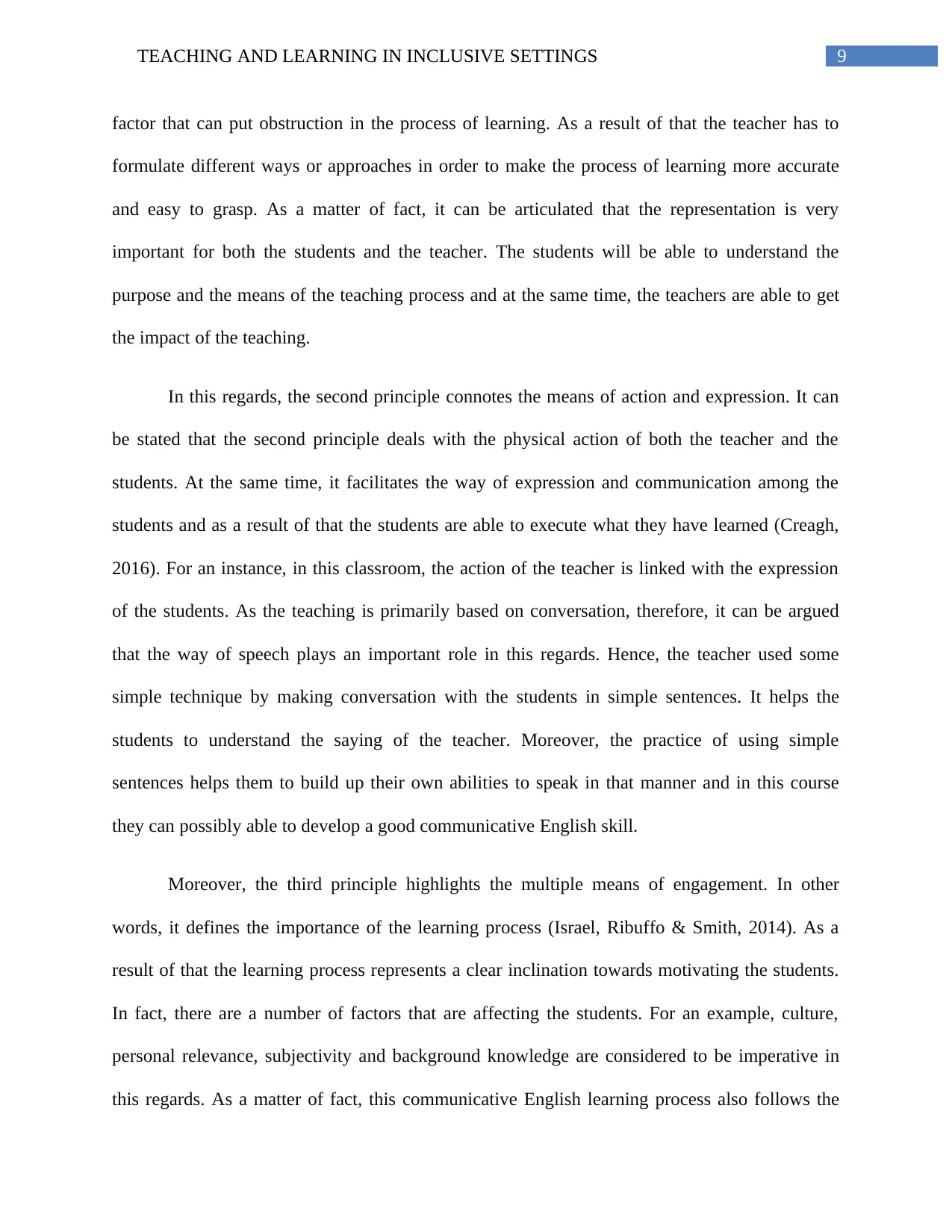
9TEACHING AND LEARNING IN INCLUSIVE SETTINGS
factor that can put obstruction in the process of learning. As a result of that the teacher has to
formulate different ways or approaches in order to make the process of learning more accurate
and easy to grasp. As a matter of fact, it can be articulated that the representation is very
important for both the students and the teacher. The students will be able to understand the
purpose and the means of the teaching process and at the same time, the teachers are able to get
the impact of the teaching.
In this regards, the second principle connotes the means of action and expression. It can
be stated that the second principle deals with the physical action of both the teacher and the
students. At the same time, it facilitates the way of expression and communication among the
students and as a result of that the students are able to execute what they have learned (Creagh,
2016). For an instance, in this classroom, the action of the teacher is linked with the expression
of the students. As the teaching is primarily based on conversation, therefore, it can be argued
that the way of speech plays an important role in this regards. Hence, the teacher used some
simple technique by making conversation with the students in simple sentences. It helps the
students to understand the saying of the teacher. Moreover, the practice of using simple
sentences helps them to build up their own abilities to speak in that manner and in this course
they can possibly able to develop a good communicative English skill.
Moreover, the third principle highlights the multiple means of engagement. In other
words, it defines the importance of the learning process (Israel, Ribuffo & Smith, 2014). As a
result of that the learning process represents a clear inclination towards motivating the students.
In fact, there are a number of factors that are affecting the students. For an example, culture,
personal relevance, subjectivity and background knowledge are considered to be imperative in
this regards. As a matter of fact, this communicative English learning process also follows the
factor that can put obstruction in the process of learning. As a result of that the teacher has to
formulate different ways or approaches in order to make the process of learning more accurate
and easy to grasp. As a matter of fact, it can be articulated that the representation is very
important for both the students and the teacher. The students will be able to understand the
purpose and the means of the teaching process and at the same time, the teachers are able to get
the impact of the teaching.
In this regards, the second principle connotes the means of action and expression. It can
be stated that the second principle deals with the physical action of both the teacher and the
students. At the same time, it facilitates the way of expression and communication among the
students and as a result of that the students are able to execute what they have learned (Creagh,
2016). For an instance, in this classroom, the action of the teacher is linked with the expression
of the students. As the teaching is primarily based on conversation, therefore, it can be argued
that the way of speech plays an important role in this regards. Hence, the teacher used some
simple technique by making conversation with the students in simple sentences. It helps the
students to understand the saying of the teacher. Moreover, the practice of using simple
sentences helps them to build up their own abilities to speak in that manner and in this course
they can possibly able to develop a good communicative English skill.
Moreover, the third principle highlights the multiple means of engagement. In other
words, it defines the importance of the learning process (Israel, Ribuffo & Smith, 2014). As a
result of that the learning process represents a clear inclination towards motivating the students.
In fact, there are a number of factors that are affecting the students. For an example, culture,
personal relevance, subjectivity and background knowledge are considered to be imperative in
this regards. As a matter of fact, this communicative English learning process also follows the
Secure Best Marks with AI Grader
Need help grading? Try our AI Grader for instant feedback on your assignments.
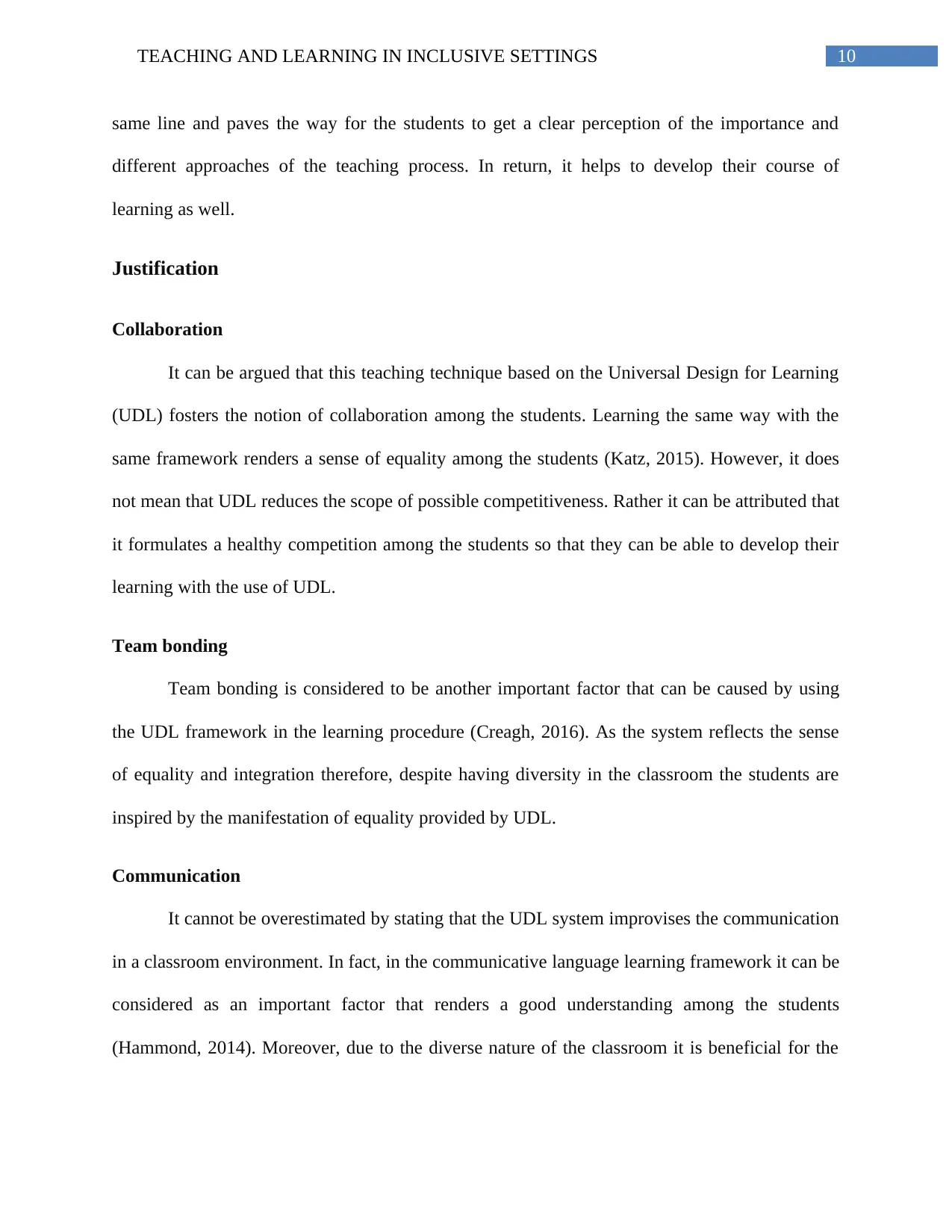
10TEACHING AND LEARNING IN INCLUSIVE SETTINGS
same line and paves the way for the students to get a clear perception of the importance and
different approaches of the teaching process. In return, it helps to develop their course of
learning as well.
Justification
Collaboration
It can be argued that this teaching technique based on the Universal Design for Learning
(UDL) fosters the notion of collaboration among the students. Learning the same way with the
same framework renders a sense of equality among the students (Katz, 2015). However, it does
not mean that UDL reduces the scope of possible competitiveness. Rather it can be attributed that
it formulates a healthy competition among the students so that they can be able to develop their
learning with the use of UDL.
Team bonding
Team bonding is considered to be another important factor that can be caused by using
the UDL framework in the learning procedure (Creagh, 2016). As the system reflects the sense
of equality and integration therefore, despite having diversity in the classroom the students are
inspired by the manifestation of equality provided by UDL.
Communication
It cannot be overestimated by stating that the UDL system improvises the communication
in a classroom environment. In fact, in the communicative language learning framework it can be
considered as an important factor that renders a good understanding among the students
(Hammond, 2014). Moreover, due to the diverse nature of the classroom it is beneficial for the
same line and paves the way for the students to get a clear perception of the importance and
different approaches of the teaching process. In return, it helps to develop their course of
learning as well.
Justification
Collaboration
It can be argued that this teaching technique based on the Universal Design for Learning
(UDL) fosters the notion of collaboration among the students. Learning the same way with the
same framework renders a sense of equality among the students (Katz, 2015). However, it does
not mean that UDL reduces the scope of possible competitiveness. Rather it can be attributed that
it formulates a healthy competition among the students so that they can be able to develop their
learning with the use of UDL.
Team bonding
Team bonding is considered to be another important factor that can be caused by using
the UDL framework in the learning procedure (Creagh, 2016). As the system reflects the sense
of equality and integration therefore, despite having diversity in the classroom the students are
inspired by the manifestation of equality provided by UDL.
Communication
It cannot be overestimated by stating that the UDL system improvises the communication
in a classroom environment. In fact, in the communicative language learning framework it can be
considered as an important factor that renders a good understanding among the students
(Hammond, 2014). Moreover, due to the diverse nature of the classroom it is beneficial for the
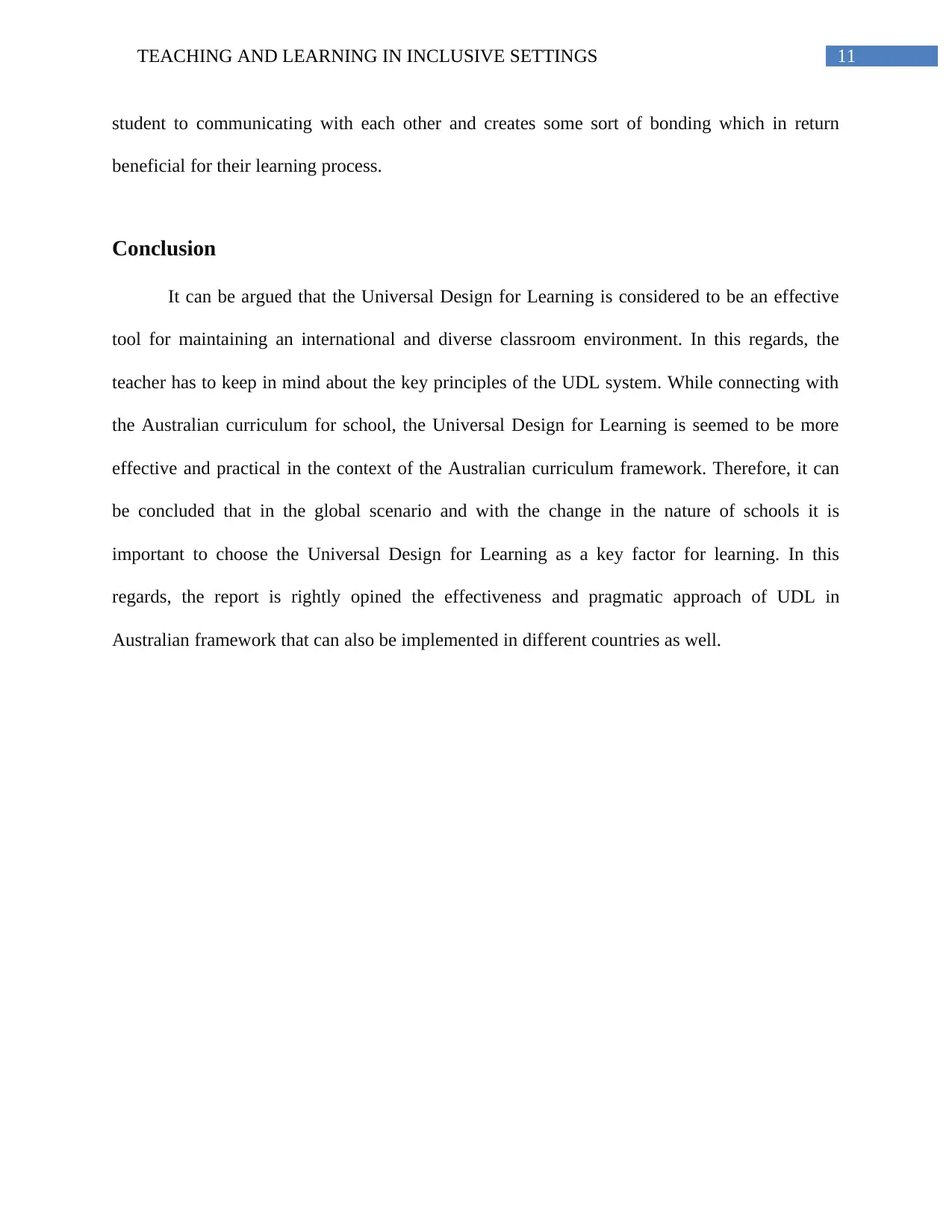
11TEACHING AND LEARNING IN INCLUSIVE SETTINGS
student to communicating with each other and creates some sort of bonding which in return
beneficial for their learning process.
Conclusion
It can be argued that the Universal Design for Learning is considered to be an effective
tool for maintaining an international and diverse classroom environment. In this regards, the
teacher has to keep in mind about the key principles of the UDL system. While connecting with
the Australian curriculum for school, the Universal Design for Learning is seemed to be more
effective and practical in the context of the Australian curriculum framework. Therefore, it can
be concluded that in the global scenario and with the change in the nature of schools it is
important to choose the Universal Design for Learning as a key factor for learning. In this
regards, the report is rightly opined the effectiveness and pragmatic approach of UDL in
Australian framework that can also be implemented in different countries as well.
student to communicating with each other and creates some sort of bonding which in return
beneficial for their learning process.
Conclusion
It can be argued that the Universal Design for Learning is considered to be an effective
tool for maintaining an international and diverse classroom environment. In this regards, the
teacher has to keep in mind about the key principles of the UDL system. While connecting with
the Australian curriculum for school, the Universal Design for Learning is seemed to be more
effective and practical in the context of the Australian curriculum framework. Therefore, it can
be concluded that in the global scenario and with the change in the nature of schools it is
important to choose the Universal Design for Learning as a key factor for learning. In this
regards, the report is rightly opined the effectiveness and pragmatic approach of UDL in
Australian framework that can also be implemented in different countries as well.
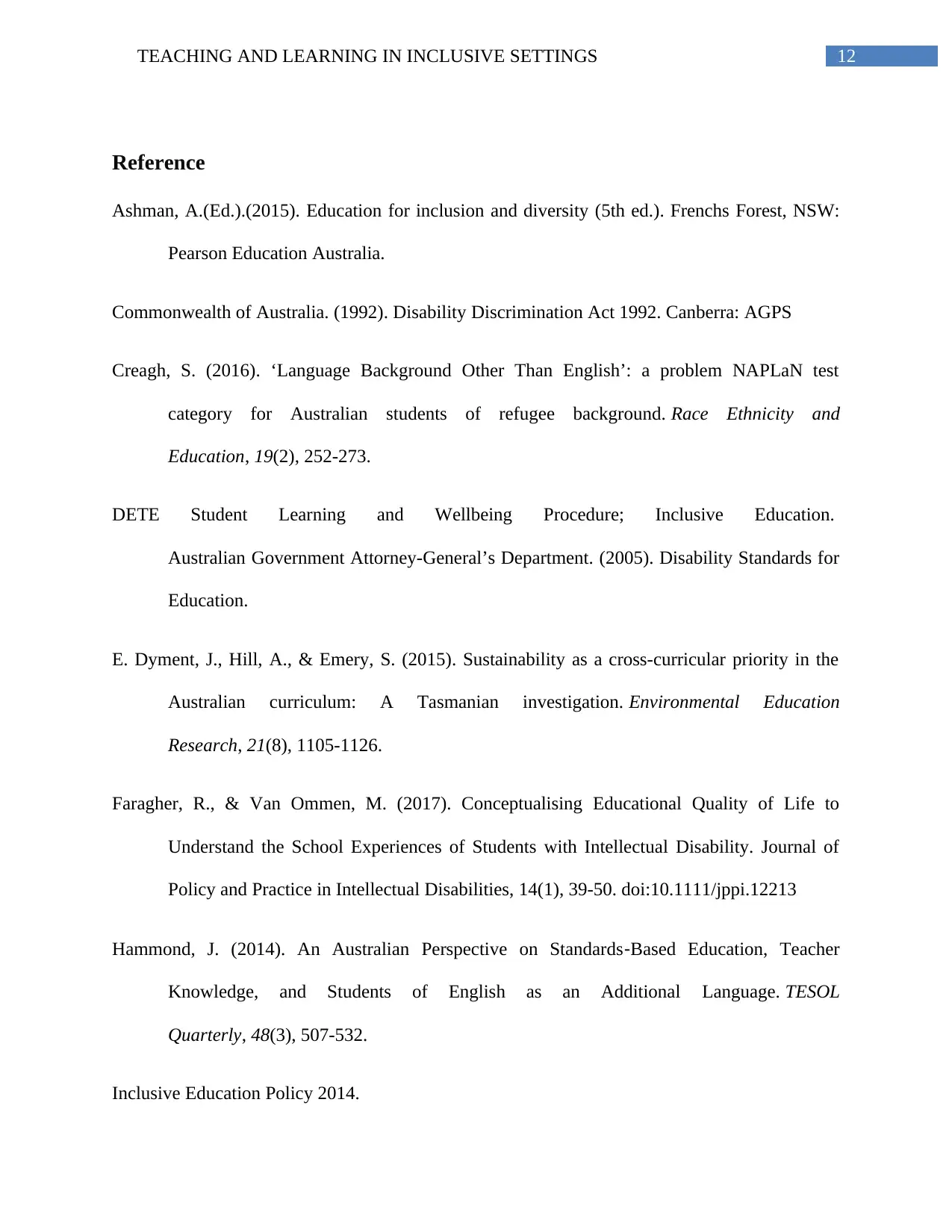
12TEACHING AND LEARNING IN INCLUSIVE SETTINGS
Reference
Ashman, A.(Ed.).(2015). Education for inclusion and diversity (5th ed.). Frenchs Forest, NSW:
Pearson Education Australia.
Commonwealth of Australia. (1992). Disability Discrimination Act 1992. Canberra: AGPS
Creagh, S. (2016). ‘Language Background Other Than English’: a problem NAPLaN test
category for Australian students of refugee background. Race Ethnicity and
Education, 19(2), 252-273.
DETE Student Learning and Wellbeing Procedure; Inclusive Education.
Australian Government Attorney-General’s Department. (2005). Disability Standards for
Education.
E. Dyment, J., Hill, A., & Emery, S. (2015). Sustainability as a cross-curricular priority in the
Australian curriculum: A Tasmanian investigation. Environmental Education
Research, 21(8), 1105-1126.
Faragher, R., & Van Ommen, M. (2017). Conceptualising Educational Quality of Life to
Understand the School Experiences of Students with Intellectual Disability. Journal of
Policy and Practice in Intellectual Disabilities, 14(1), 39-50. doi:10.1111/jppi.12213
Hammond, J. (2014). An Australian Perspective on Standards‐Based Education, Teacher
Knowledge, and Students of English as an Additional Language. TESOL
Quarterly, 48(3), 507-532.
Inclusive Education Policy 2014.
Reference
Ashman, A.(Ed.).(2015). Education for inclusion and diversity (5th ed.). Frenchs Forest, NSW:
Pearson Education Australia.
Commonwealth of Australia. (1992). Disability Discrimination Act 1992. Canberra: AGPS
Creagh, S. (2016). ‘Language Background Other Than English’: a problem NAPLaN test
category for Australian students of refugee background. Race Ethnicity and
Education, 19(2), 252-273.
DETE Student Learning and Wellbeing Procedure; Inclusive Education.
Australian Government Attorney-General’s Department. (2005). Disability Standards for
Education.
E. Dyment, J., Hill, A., & Emery, S. (2015). Sustainability as a cross-curricular priority in the
Australian curriculum: A Tasmanian investigation. Environmental Education
Research, 21(8), 1105-1126.
Faragher, R., & Van Ommen, M. (2017). Conceptualising Educational Quality of Life to
Understand the School Experiences of Students with Intellectual Disability. Journal of
Policy and Practice in Intellectual Disabilities, 14(1), 39-50. doi:10.1111/jppi.12213
Hammond, J. (2014). An Australian Perspective on Standards‐Based Education, Teacher
Knowledge, and Students of English as an Additional Language. TESOL
Quarterly, 48(3), 507-532.
Inclusive Education Policy 2014.
Paraphrase This Document
Need a fresh take? Get an instant paraphrase of this document with our AI Paraphraser
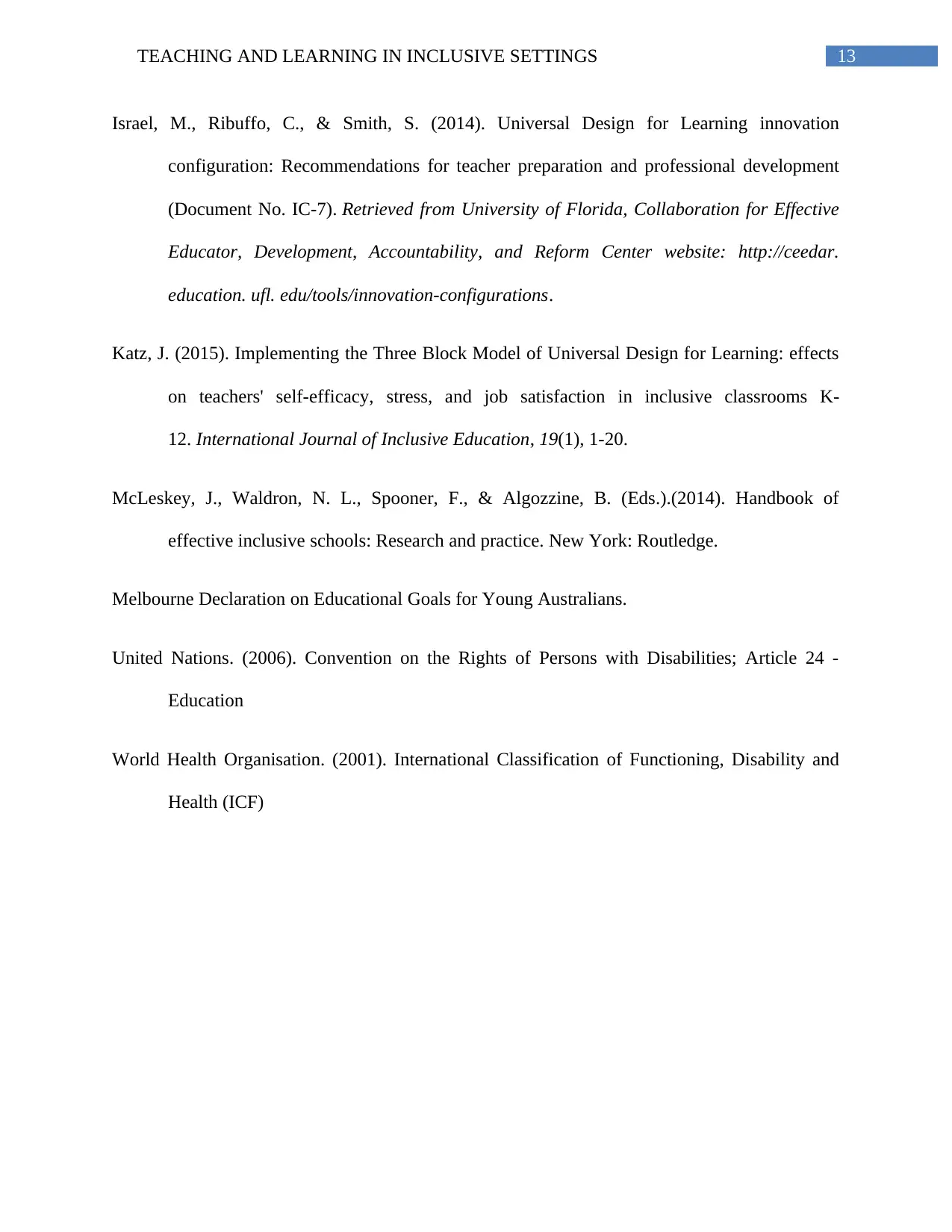
13TEACHING AND LEARNING IN INCLUSIVE SETTINGS
Israel, M., Ribuffo, C., & Smith, S. (2014). Universal Design for Learning innovation
configuration: Recommendations for teacher preparation and professional development
(Document No. IC-7). Retrieved from University of Florida, Collaboration for Effective
Educator, Development, Accountability, and Reform Center website: http://ceedar.
education. ufl. edu/tools/innovation-configurations.
Katz, J. (2015). Implementing the Three Block Model of Universal Design for Learning: effects
on teachers' self-efficacy, stress, and job satisfaction in inclusive classrooms K-
12. International Journal of Inclusive Education, 19(1), 1-20.
McLeskey, J., Waldron, N. L., Spooner, F., & Algozzine, B. (Eds.).(2014). Handbook of
effective inclusive schools: Research and practice. New York: Routledge.
Melbourne Declaration on Educational Goals for Young Australians.
United Nations. (2006). Convention on the Rights of Persons with Disabilities; Article 24 -
Education
World Health Organisation. (2001). International Classification of Functioning, Disability and
Health (ICF)
Israel, M., Ribuffo, C., & Smith, S. (2014). Universal Design for Learning innovation
configuration: Recommendations for teacher preparation and professional development
(Document No. IC-7). Retrieved from University of Florida, Collaboration for Effective
Educator, Development, Accountability, and Reform Center website: http://ceedar.
education. ufl. edu/tools/innovation-configurations.
Katz, J. (2015). Implementing the Three Block Model of Universal Design for Learning: effects
on teachers' self-efficacy, stress, and job satisfaction in inclusive classrooms K-
12. International Journal of Inclusive Education, 19(1), 1-20.
McLeskey, J., Waldron, N. L., Spooner, F., & Algozzine, B. (Eds.).(2014). Handbook of
effective inclusive schools: Research and practice. New York: Routledge.
Melbourne Declaration on Educational Goals for Young Australians.
United Nations. (2006). Convention on the Rights of Persons with Disabilities; Article 24 -
Education
World Health Organisation. (2001). International Classification of Functioning, Disability and
Health (ICF)
1 out of 14
Related Documents
Your All-in-One AI-Powered Toolkit for Academic Success.
+13062052269
info@desklib.com
Available 24*7 on WhatsApp / Email
![[object Object]](/_next/static/media/star-bottom.7253800d.svg)
Unlock your academic potential
© 2024 | Zucol Services PVT LTD | All rights reserved.




